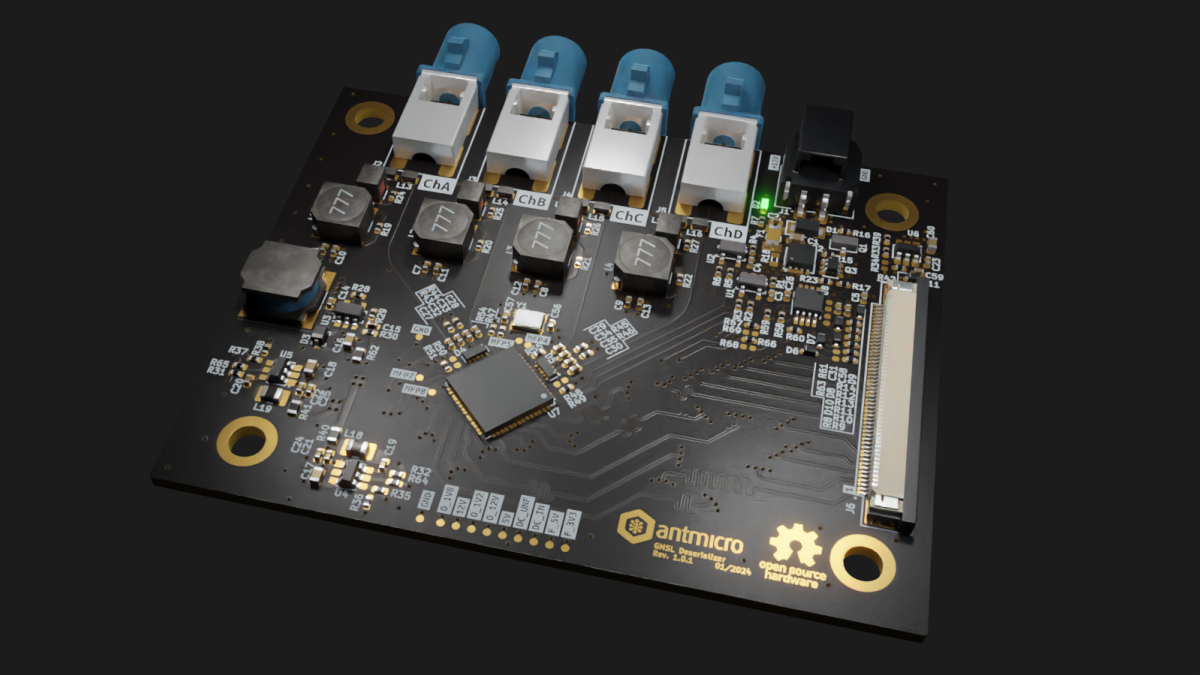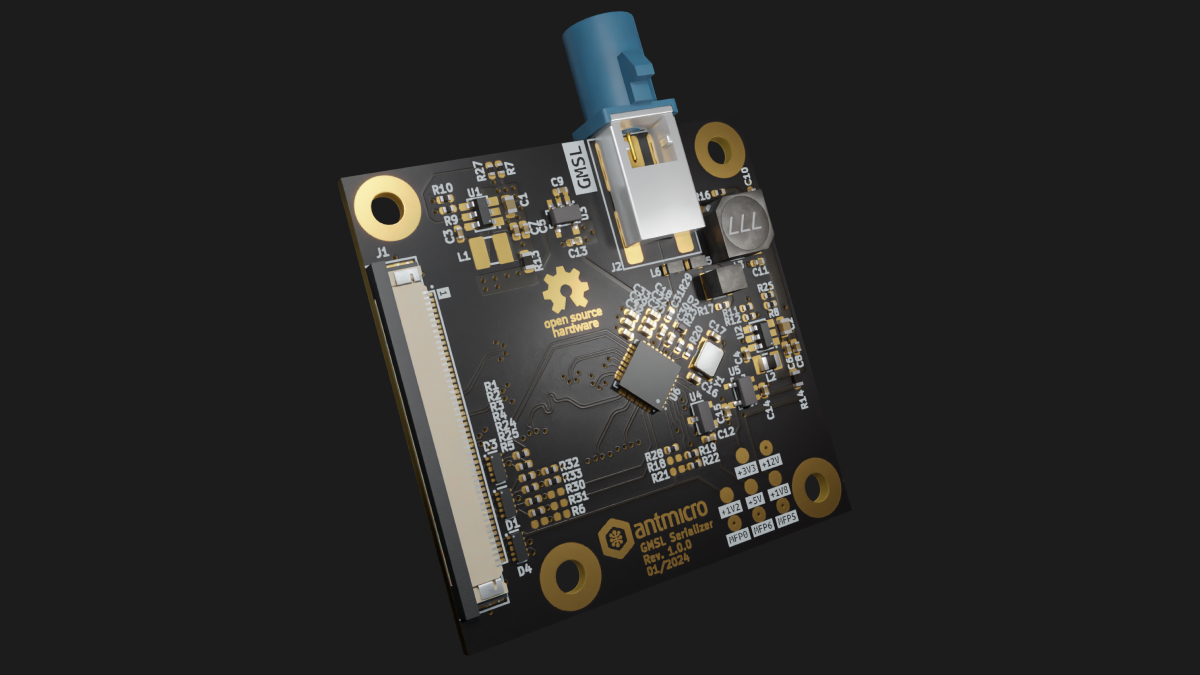Robust camera systems with Antmicro’s open source GMSL video streaming hardware
Published:
Topics: Open hardware, Edge AI
Antmicro’s projects often revolve around video acquisition and processing, with the camera system sometimes placed at a longer distance from the embedded processing platform. In such scenarios we cannot directly use MIPI CSI (Camera Serial Interface), which is the most common interface available in embedded boards – in its current form, MIPI CSI was designed for mobile phones where the distance between the camera and SoC is relatively short. Although some efforts to expand MIPI’s applications have been in progress for a while now, resulting in a new MIPI PHY standard called A-PHY, adoption of this solution is low due to its relative novelty.
To transmit video data over longer distances, companies developing industrial products have had to rely on a variety of external SerDes (serializer-deserializer) solutions. Among the many competing SerDer standards, GMSL (Gigabit Multimedia Serial Link) provides not only high-speed data transmission, but also EMI reduction and long-range coverage. These qualities make it a good match for a variety of industrial applications – from cars, through rovers, robots and drones, to smart city solutions – and we have been supporting a number of customers to build their GMSL solutions for these use cases.
In this note, we introduce Antmicro’s open source GMSL video streaming modules: GMSL Serializer and GMSL Deserializer. This project has joined a large portfolio of our open source hardware boards, which includes converters to MIPI from other standards, such as HDMI-MIPI and SDI-MIPI.
Combining this GMSL SerDes solution with our open hardware baseboards, such as those we developed for Jetson Nano or Jetson Orin, allows us to rapidly prototype entire systems and proceed with early software development while a customized hardware platform tailored for use in the final product is being developed by our hardware team.
GMSL – a comprehensive data transmission protocol
GMSL originated in the automotive industry – it is used for video inputs to pretty much all the ADAS (Advanced Driver-Assistance System) solutions to realize the connection for a centralized, high-power compute system typically placed somewhere close to the dashboard with camera systems that are – out of necessity – spread around the vehicle. GMSL offers more than just video transmission – there are dedicated chips that wrap CSI into GMSL along with power supply and control signals, and even some sideband communication. One of the main advantages of GMSL is its decent range, as it can operate at distances up to 15 meters. It also uses round coaxial cables consisting of just two wires, which greatly simplifies cabling setup and installation inside a robot or a car.
GMSL allows connecting a single video source to a single MIPI-CSI channel but it also supports so-called virtual MIPI CSI channels, so that multiple video sources can be connected to a single MIPI CSI port. This can be useful while building video applications targeting the latest NVIDIA Jetson Orin family of SoMs which have a reduced number of CSI interfaces as compared to their predecessors. The GMSL standard evolves over time, bringing more throughput with each iteration. The consecutive revisions are simply called GMSL1, GMSL2 and GMSL3 and are backwards compatible.
Antmicro’s GMSL deserializer
Antmicro’s GMSL Deserializer Board is an accessory capable of translating up to 4 GMSL signals into 2x 4-lane MIPI CSI-2 interfaces. It unpacks the video data in MIPI-CSI format and provides it to the host platform using MAX96724 which is a GMSL Gen1 and Gen2 deserializer with four GMSL inputs and two output channels with configurable 1, 2 or 4-lane MIPI CSI interfaces. The deserializer’s GPIO is at the 1.8V logic level, although I2C is shifted to 3.3V. VSYNC signals are buffered, so they can be up to 5V. Data and power lines on the FFC connector are protected by TVS diodes.
The GMSL deserializer board uses a FAKRA plug (male) with neutral “Z” key coding as a connector, and accommodates FAKRA jack (female) connectors with the maximum width of 11mm. This allows us to interface a plethora of GMSL-enabled video sources with our portfolio of open hardware baseboards.

Antmicro’s GMSL serializer
To have a complete solution for rapid prototyping, Antmicro also created a serializer board that packs the MIPI CSI video data into GMSL, complementary to the deserializing board described above. The GMSL Serializer translates the parallel MIPI-CSI 2 signal to the serial GMSL2 signal. The default configuration of the board supports 4-lane MIPI CSI-2 input and GMSL2 6Gbps output. It exposes the same FAKRA connector as the GMSL Deserializer board.
The serializer is powered over a coaxial cable which delivers 12V, 1A and has a PoC filter which can be adjusted to work with both GMSL1 and GMSL2 standards. In the default configuration, filter components are selected to work with the faster GMSL2 6Gps standard. This board enables upgrading existing CSI-2 devices compatible with Antmicro’s open hardware boards into GMSL links.

Integrating the GMSL video streaming hardware with Antmicro’s baseboards and video accessories
The Antmicro GMSL Serializer allows interfacing with camera solutions from our partners Allied Vision and Framos. You can connect an Allied Vision Alvium CSI-2 camera or a set consisting of a Framos Sensor Module (FSM) and a Framos Sensor Module Adapter (FSA) to the 50-pin camera interface connector using Antmicro’s dedicated accessories: Alvium Flexible CSI Adapter, Framos CSI Adapter and Dual I-PEX CSI Interposer.
The Antmicro GMSL Deserializer Board exposes MIPI CSI-2 interfaces using unified 50-pin connectors that are electrically compatible with a variety of embedded open hardware boards created by Antmicro, covering platforms like Jetson Nano, Jetson Orin, Snapdragon 845, Snapdragon 625 and the Zynq UltraScale+.

Both GMSL boards will soon also be available on our Open Hardware Portal, along with component lists, 3D visualizations, stackup views and more. The development, as always, was an opportunity to expand our hardware component database and further develop our open source, advanced visualization flow, which shows its usefulness especially in scenarios involving interplay between different elements of the hardware systems that we build.
Build GMSL-enabled camera systems with Antmicro
The GMSL SerDes hardware described above, together with a baseboard, MIPI CSI-2 camera modules and cabling, provides a complete solution for building robust camera systems, capable of not only high-speed and low-latency video data acquisition, but also specialized processing, local AI inferencing, sending the data to cloud and more.
Antmicro’s comprehensive services including specialized software and tool development, combined with a wide range of open source video processing platforms and camera accessories, provide a great starting point for developing PoC devices, also for edge AI scenarios. Thanks to our partnership with camera vendors like FRAMOS, we’ve been helping customers build around a variety camera modules to create complete camera systems employing Antmicro’s AI-enabled platforms.
If you’re interested in integrating GMSL into your project or want to discuss developing your next camera system with Antmicro, don’t hesitate to contact us at contact@antmicro.com.

